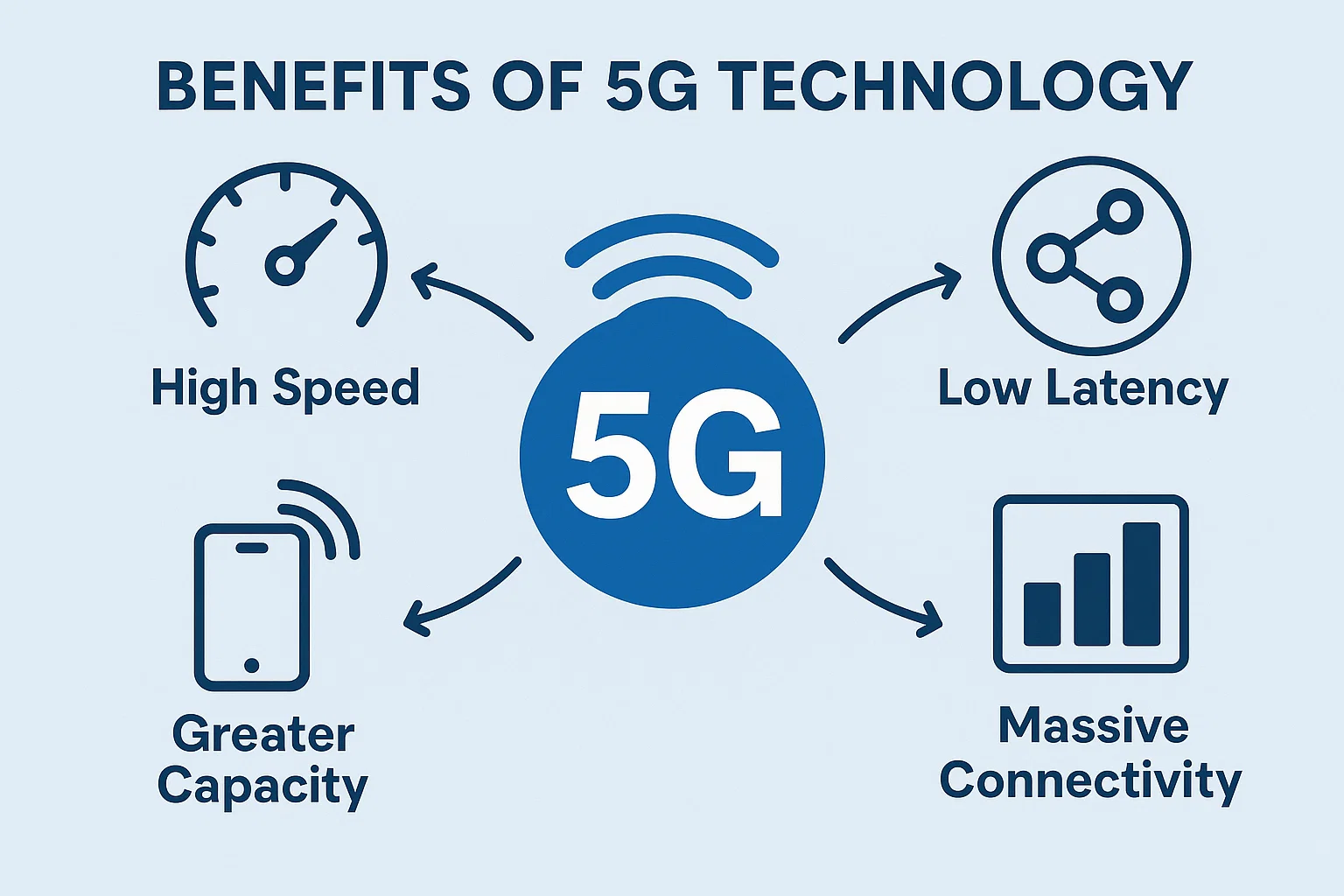The Benefits of 5G Technology: Transforming the Future of Connectivity
5G, or fifth-generation wireless technology, is more than just a faster internet connection—it’s a revolutionary leap that promises to transform the way we live, work, and interact with the world. With unprecedented speed, ultra-low latency, and massive connectivity, 5G has the potential to power everything from real-time video streaming and smart homes to autonomous vehicles and remote surgeries.
In this article, we explore the key benefits of 5G technology, its practical applications, and how it is poised to reshape industries and societies worldwide.
1. Lightning-Fast Speeds
One of the most celebrated features of 5G is its blazing-fast internet speeds. While 4G networks offer download speeds of up to 100 Mbps, 5G can deliver speeds up to 10 Gbps—a hundred times faster.
How This Benefits You:
- Faster downloads: Download HD movies in seconds.
- Smoother streaming: Enjoy 4K/8K video without buffering.
- Better gaming: Online games load faster with less lag.
- Improved productivity: Cloud applications and file transfers become seamless.
2. Ultra-Low Latency
Latency is the delay between sending and receiving data. 5G offers latency as low as 1 millisecond, compared to around 30-50 milliseconds with 4 G.
Benefits of Low Latency:
- Real-time responsiveness: Ideal for applications like remote surgery or autonomous driving.
- Enhanced gaming experience: Crucial for AR/VR and competitive gaming.
- Efficient industrial automation: Robots and machines respond instantly to commands.
3. Massive Device Connectivity
5G can support up to 1 million devices per square kilometer, making it perfect for the growing Internet of Things (IoT) ecosystem.
Use Cases:
- Smart homes: Connect appliances, lighting, and security systems.
- Smart cities: Power sensors for traffic control, energy usage, and pollution monitoring.
- Healthcare wearables: Track patient vitals in real time.
- Agricultural automation: Monitor soil, crops, and weather using smart devices.
4. Revolutionizing Healthcare
5G is set to transform the healthcare industry by enabling high-quality, real-time, and remote medical services.
Key Benefits:
- Remote surgeries: Surgeons can operate using robots from thousands of miles away with real-time precision.
- Telemedicine enables high-quality video consultations and diagnostics.
- Emergency response: Real-time data sharing between ambulances and hospitals can save lives.
- Health monitoring: Wearables and implants can continuously track patient conditions.
5. Empowering Smart Cities
With the rise of urbanization, cities are embracing smart technology to enhance their infrastructure, services, and overall quality of life.
How 5G Powers Smart Cities:
- Traffic management: Real-time traffic data and autonomous vehicle coordination.
- Public safety: Surveillance systems with facial recognition and emergency alerts.
- Energy efficiency: Smart grids and lighting systems to reduce waste.
- Waste management: Sensors to monitor and optimize garbage collection routes.
6. Boosting Industrial Automation
Also known as Industry 4.0, the integration of 5G in manufacturing and logistics enables real-time communication between machines, sensors, and humans.
Benefits Include:
- Predictive maintenance: Machines alert technicians before breakdowns.
- Robotic automation: Synchronize operations with high precision.
- Remote monitoring: Control factories and equipment from anywhere.
- Enhanced supply chains: Real-time tracking of goods and materials.
7. Advancing Autonomous Vehicles
5G technology is essential for the safe and efficient operation of autonomous cars, drones, and public transportation systems.
Key Features:
- Instant communication: Vehicles communicate with each other (V2V), infrastructure (V2I), and pedestrians (V2P).
- Collision prevention: Immediate data sharing reduces accident risks.
- Optimized navigation: Real-time updates on road conditions and traffic patterns.
- Smart parking: Cars locate and reserve parking spots automatically.
8. Enhancing Augmented and Virtual Reality (AR/VR)
5G will dramatically improve the quality and experience of AR and VR technologies.
How It Helps:
- Seamless experiences: Ultra-low latency eliminates lag and motion sickness.
- Immersive education: Virtual classrooms and 3D learning environments.
- Virtual tourism: Explore landmarks and destinations in real-time.
- Remote collaboration: Teams meet in virtual spaces for presentations, design, or brainstorming.
9. Supporting Remote Work and Education
The COVID-19 pandemic accelerated the adoption of remote work and online learning. 5G strengthens this trend with more stable, high-speed connections.
Benefits for Remote Workers and Students:
- Better video conferencing: No freezing or poor quality.
- Faster file uploads/downloads: Improves workflow and productivity.
- Multi-device connectivity: Connect all gadgets without slowing the network.
- Rural accessibility: Brings high-speed internet to underserved areas.
10. Green Technology & Sustainability
5G can also contribute to environmental sustainability by improving resource efficiency and reducing emissions.
Green Benefits:
- Smart farming: Optimize water usage, pesticide application, and crop yields.
- Reduced commuting: Remote work reduces traffic and CO₂ emissions.
- Efficient logistics: Real-time data helps reduce fuel consumption.
- Smart buildings: Manage heating, cooling, and lighting based on real-time usage.
11. Economic Growth and Innovation
5G is not just a tech upgrade—it’s an economic enabler that drives innovation, creates jobs, and boosts productivity.
Economic Impact:
- New industries: Enables emerging sectors like drone deliveries, smart manufacturing, and telemedicine.
- Startups and entrepreneurs: Open doors for innovative applications and business models.
- Job creation: Boosts employment in tech, telecom, infrastructure, and service sectors.
- Global competitiveness: Countries leading in 5G infrastructure gain a strategic advantage.
12. Improved Public Safety and Disaster Response
5G enhances communication during natural disasters, emergencies, and law enforcement operations.
How 5G Helps:
- Drones for search & rescue: Real-time visuals from disaster zones.
- Faster emergency response: Share video, location, and data instantly.
- Better coordination: Seamless communication between police, firefighters, and medical staff.
- Public alerts: Real-time warnings for earthquakes, floods, or security threats.
13. Personalized and Smart Consumer Experiences
With enhanced data processing and connectivity, 5G enables personalized experiences in retail, entertainment, and customer service.
Examples:
- Smart mirrors in stores: Try on clothes virtually.
- Interactive shopping: Use AR to visualize furniture in your home.
- Customized ads: Based on real-time preferences and behaviors.
- AI-powered assistants: Handle customer queries instantly with context.
14. Global Connectivity & Bridging the Digital Divide
5G can help reduce the global digital divide by delivering fast, reliable internet access to remote or underserved regions.
Benefits:
- Improved education: Online learning for rural students.
- Economic inclusion: Digital access opens up job and income opportunities.
- Healthcare access: Remote consultations for isolated areas.
- Social inclusion: Connect with family, government services, and digital platforms.
Conclusion
5G technology is more than just a faster network—it’s a transformative force across all areas of life. From improving healthcare and empowering industries to creating smarter cities and enabling immersive digital experiences, the benefits of 5G are vast and far-reaching.
As 5G continues to roll out globally, it promises a future of greater connectivity, smarter solutions, and unprecedented possibilities. Whether you’re a business owner, a student, a gamer, or just an everyday internet user, the impact of 5G will soon be felt in everything you do.
FAQs About 5G Technology
Q1: Is 5G safe for health?
Yes. Numerous studies and regulatory bodies, including the WHO and FCC, confirm that 5G operates within safe limits for human exposure to radiofrequency radiation.
Q2: How is 5G different from 4G?
5G is significantly faster, supports more devices, offers lower latency, and enables more advanced technologies like IoT, AR/VR, and autonomous systems.
Q3: When will 5G be widely available?
Many countries have already begun rolling out 5G networks. Widespread availability is expected within the next 2–3 years, depending on infrastructure and investment.
Q4: Do I need a new phone for 5G?
Yes. To access 5G networks, you need a 5G-compatible smartphone or device.
Read More AI and the Future of Social Media

